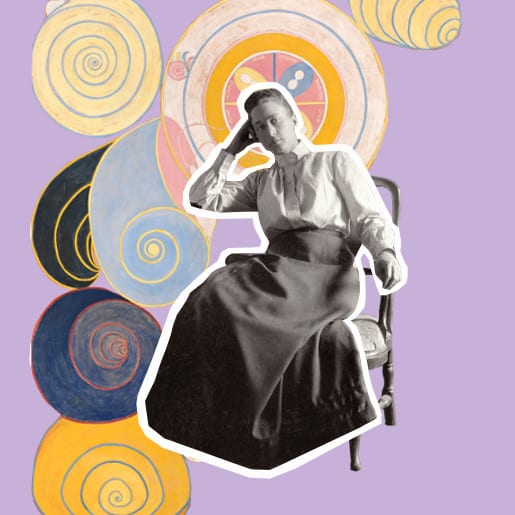You’ve probably never heard about Hilma af Klint. Neither had I, until a couple of years ago when I watched Olivier Assayas’s movie Personal Shopper. In the five-minute sequence in which she’s mentioned, she’s introduced as the woman who “invented abstract art before Kandinsky and Malevich.” This was enough to tickle my curiosity.
I Googled her and was immediately and irremediably seduced by the breathtaking beauty of her artwork. Whether immense, pastel-colored symbols or bright and geometric patterns, the works are those of a talented artist, well ahead of her time.
Hilma af Klint was, indeed, a true precursor. She painted most of her abstract works between 1906 and 1915, whereas Kandinsky’s painting—considered to be the first abstract artwork—wasn’t displayed before 1911. But while Kandinsky’s name is known to all, af Klint’s has sunk into oblivion and it’s only very recently that she started to get the recognition she truly deserves. Her story as an artist is such an extraordinary one that it partly explains why her work has been overlooked for years.
Born in 1862 in Sweden, Hilma af Klint entered Stockholm’s Royal Painting Academy in 1882, a true achievement, since very few women were admitted into the institution at the time. She received a training in classical figurative painting and later earned a living selling her works, mostly landscapes. Most of the people she met during her life knew her as a discreet and reasonably successful painter.
Af Klint developed an interest for esoteric religions and formed a group known as ‘De Fem’ (‘The Five’) with four other women. Together, they conducted séances and tried to communicate with spirits. In order to do so, af Klint invented a new pictorial language made of symbols and color combinations. She later used it as the basis for her major series of works, the “Paintings for the Temple,” a series she started in 1906 that allegedly had been “commissioned by the spirits.” These paintings depict the different stages of human existence using abstract symbols, and are probably her most compelling work.
In her lifetime, af Klint only showed her abstract works to very few people, and they reacted with such skepticism that she decided to keep them a secret, thinking that her contemporaries were not yet ready to see them. Upon her death in 1944, she bequeathed on her nephew about 1,000 works and 150 sketchbooks, sealed in boxes, instructing him to wait for 20 years before revealing them.
When her art was exhibited for the first time in 1986, art lovers and historians alike were seduced by its quality and modernity, but it remains extremely difficult to pin down her role in the history of art. Her isolation from other artistic movements and the secrecy of her works mean that despite being the first person to create truly abstract artwork, her impact on modern occidental art is almost nonexistent.
Thankfully, the emotional intensity of af Klint’s works does not depend on her place in the history of art. Maybe her extraordinary story allows us to approach them not with preconceived ideas about their value, but with an open heart.
Royal Academy of Arts: https://www.royalacademy.org.uk/article/hilma-af-klint?gclid=CjwKCAiA_ZTfBRBjEiwAN6YG4dLDSGlaE1gUMxRiNvuA4H8QCXfx4JFTdY6Cc1eSypVA4xDbTiiN8hoCcr8QAvD_BwE&gclsrc=aw.ds
Tate: https://www.tate.org.uk/context-comment/articles/first-abstract-artist-and-its-not-kandinsky
Guggenheim: https://www.guggenheim.org/exhibition/hilma-af-klint
Serpentine Galleries: https://www.serpentinegalleries.org/exhibitions-events/hilma-af-klint-painting-unseen / https://www.serpentinegalleries.org/files/downloads/hilma_af_klint_wall_texts.pdf
Hilma af Klint Foundation: https://www.hilmaafklint.se/hilma-af-klint-foundation/
The Guardian: https://www.theguardian.com/artanddesign/2016/feb/21/hilma-af-klint-occult-spiritualism-abstract-serpentine-gallery
Moderna Museet: https://www.modernamuseet.se/stockholm/en/exhibitions/hilma-af-klint-2/about-the-artist/
Artsy: https://www.artsy.net/article/artsy-editorial-swedish-mystic-hilma-af-klint-invented-abstract-art
Personal Shopper, directed by Olivier Assayas, 2017
Like this post? View similar content here: Doria Shafik, the Egyptian Feminist Who Never Gave Up





